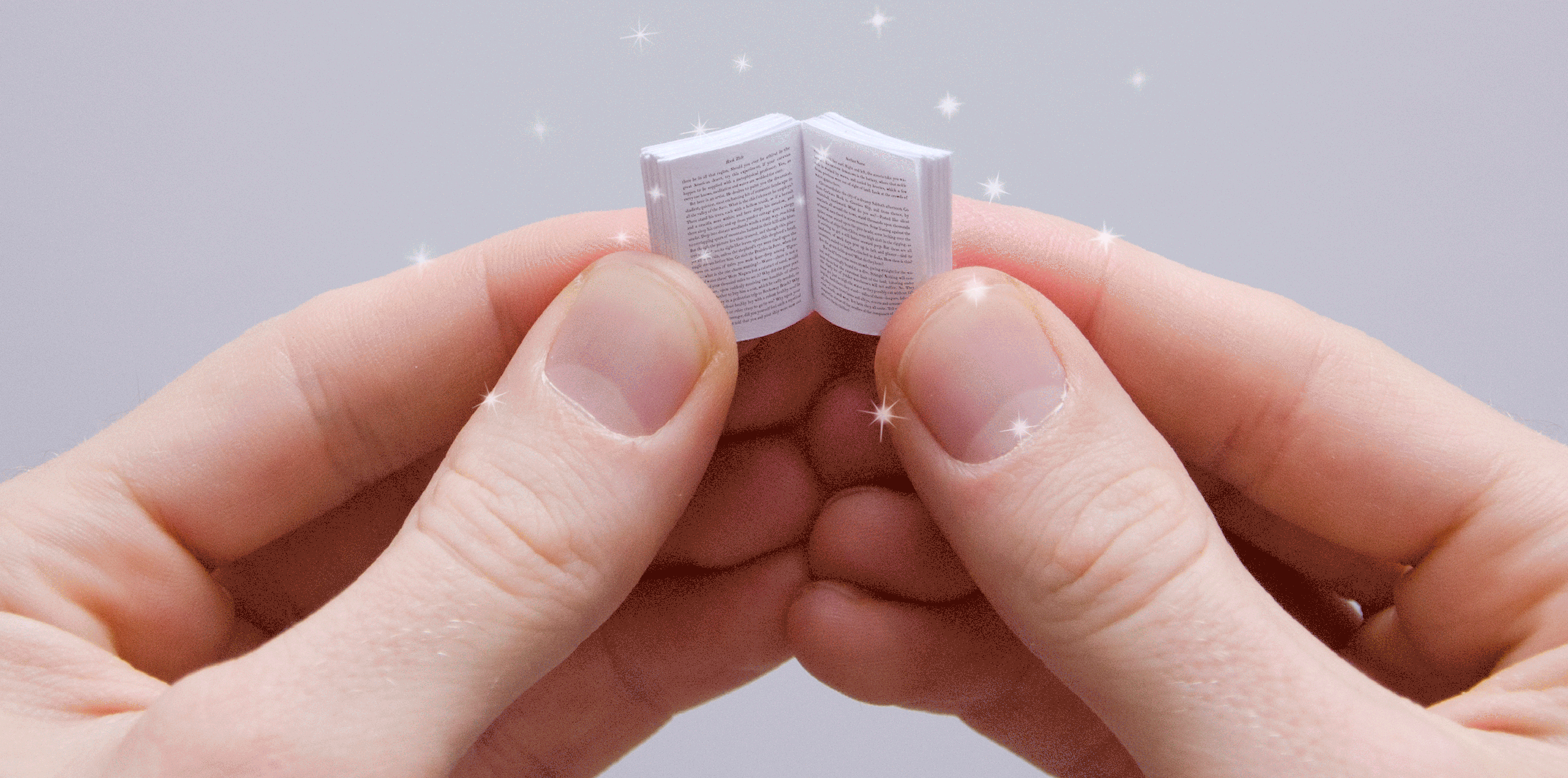In his history “Twee: The Gentle Revolution in Music, Books, Television, Fashion, and Film,” the critic Marc Spitz describes America’s collective turn toward calculated precocity as the most powerful youth movement “since Punk and Hip Hop.” Twee’s core characteristics, Spitz argues, include “a healthy suspicion of adulthood,” “a steadfast focus on our essential goodness,” “the cultivation of a passion project,” and “the utter dispensing with of ‘cool’ as it’s conventionally known, often in favor of a kind of fetishization of the nerd, the geek, the dork, the virgin.”
As if to corroborate Spitz’s thesis about our Great Twee-ification, Dutton Books for Young Readers, a division of Penguin Random House, is releasing a series of tiny books that give the act of reading a studied whimsy. Dwarsliggers, the Dutch name for these palm-sized, horizontal codexes, are already popular overseas; they are flirtatious, cocktail-party packagings of novels by authors from Ian McEwan to Agatha Christie—pigs in a blanket to the usual hot dog. “The tiny editions are the size of a cellphone and no thicker than your thumb, with paper as thin as onion skin,” the Times’ Alexandra Alter explains. “They can be read with one hand—the text flows horizontally, and you can flip the pages upward, like swiping a smartphone.” The font is slightly smaller than that of a standard book. For its first foray into the mini-books market, Dutton is reissuing four young-adult novels, available individually or in a boxed set, by the blockbuster amanuensis of adolescent yearning John Green.
Green is a standard-bearer for twee, and thus a logical author to lead the American dwarsligger insurgency. He writes for young adults, about young adults, with a teenager’s earnestness and aching emotional intensity. The theme of his stories, from “Paper Towns” to “The Fault in Our Stars,” is the struggle between innocence and experience—between bullies, sickness, and sadness, on one side, and, on the other, courage, tenderness, and beauty. Green’s characters are sweet, hyperverbal smarty-pants; they memorize poetry and say things like “I just want to do something that matters. Or be something that matters. I just want to matter.” They orchestrate chaste sleepovers, during which they lie raptly awake “talking about The Sound and the Fury and meiosis and the Battle of the Bulge.” And then they break each other’s hearts.
Green’s sensibility—wispy longing, self-deprecating charm—finds its proper correlative in mini-books. (He also happens to be galactically popular, with more than five million Twitter followers and fifty-million-plus copies of his novels in print.) And, let’s face it, literature is already a little bit twee—it’s the dorky underdog who acquires, in the trenches of the human condition, a sexy, heroic sheen.
A dwarsligger’s teeniness is inseparable from its tweeness. But dwarsliggers embody twee in another respect: as displays of individualism, idiosyncrasy, quirkiness. Such exhibitions privilege cosmetics over function, the vague intellectual mystique surrounding the fact of bookness over the book itself. In a Vulture piece that explores “the siren call of books as props,” Hillary Kelly runs through a taxonomy of Instagram tropes: the color-coded bookshelf, the wrong-end-out bookshelf that obscures the books’ titles, the lady reader splayed across a sea of dusky pages. The Times article notes that, “with their appeal as design objects,” dwarsliggers might soon be sold at “furniture and design stores and outlets like Urban Outfitters and Anthropologie.”
But perhaps these mini-volumes aren’t just decorative. Perhaps they advance the state of biblio-technology. They make the acrobatics of urban reading—standing up on the subway, stashing your book in a roomy pocket—slightly easier. Julie Strauss-Gabel, the president of Dutton, spoke of tempting younger readers by re-creating some of the digital trance of scrolling. The dwarsligger “is much closer to a cellphone experience than standard books,” Green said, “but it’s much closer to a book than a cellphone.”
The covers of the four John Green novels are the same as the full-size books, but the text and images are flipped on their sides. Reading them immediately felt intimate, with a hint of antique ceremony: the pages are as thin as those of a hotel Bible, and not very easy to turn. There’s also no obvious way to mark your place. (I ended up slipping a loose Band-Aid—unused—between the pages when I had to stop.) I liked reading “Looking for Alaska” in bed. As with a Kindle, I didn’t have to keep turning over every time I flipped a page, and my arms didn’t get tired from holding the book above my face. I read “An Abundance of Katherines” in a shoe store while my companion shopped, and it felt analogous to checking the Internet on my phone to pass the time. The mini-novel qua object is a statement, and yet the performative edge to reading in public—the sense of subtracting yourself from your surroundings—recedes when you do it with a dwarsligger.
There is a cuteness, an unseriousness, to these books. You yourself feel miniaturized—more of a chihuahua than a seeker of knowledge. As with reading on your phone, though, after a while you forget the means by which you are absorbing the text. Green’s writing is bright, immersive, and flowing. It is not hard to give yourself over—to quiet the dyspepsia of your curmudgeonly heart, if not the protests of your elderly eyes. Dwarsliggers take after Green’s protagonists: one can will oneself to love their quirks.

